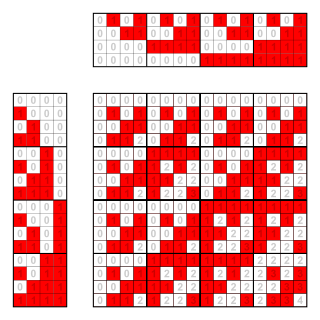Walsh matrix


(0,15, 7,8, 3,12, 4,11, 1,14, 6,9, 2,13, 5,10),
in the sequency ordered matrix the number of sign changes is consecutive.

The ones in the triangular matrices form Sierpinski triangles. The entries of the diagonal matrix are values from Gould's sequence, with the minus signs distributed like the ones in Thue–Morse sequence.

The binary matrix (white 0, red 1) is the result with operations in F2. The gray numbers show the result with operations in R.
In mathematics, a Walsh matrix is a specific square matrix with dimensions of some power of 2, entries of ±1, and the property that the dot product of any two distinct rows (or columns) is zero. The Walsh matrix was proposed by Joseph L. Walsh in 1923.[1] Each row of a Walsh matrix corresponds to a Walsh function.
The natural ordered Hadamard matrix is defined by the recursive formula below, and the sequency ordered Hadamard matrix is formed by rearranging the rows so that the number of sign-changes in a row is in increasing order.[1] Confusingly, different sources refer to either matrix as the Walsh matrix.
The Walsh matrix (and Walsh functions) are used in computing the Walsh transform and have applications in the efficient implementation of certain signal processing operations.
Formula
The Hadamard matrices of dimension 2k for k ∈ N are given by the recursive formula
The lowest order of Hadamard matrix is 2
and in general
for 2 ≤ k ∈ N, where denotes the Kronecker product.
Permutation
rearrange the rows of Matrix according the number of sign change of each row. for example:
the successive rows have 0, 3, 1, and 2 sign changes, then we rearrange the rows in sequency ordering.
e.g.
where the successive rows have 0, 1, 2, and 3 sign changes.
Alternative Forms of the Walsh Matrix
Sequency ordering
The sequency ordering of the rows of the Walsh matrix can be derived from the ordering of the Hadamard matrix by first applying the bit-reversal permutation and then the Gray code permutation.[2]
e.g.
where the successive rows have 0, 1, 2, 3, 4, 5, 6, and 7 sign changes.
Dyadic ordering
where the successive rows have 0, 1, 3, 2, 7, 6, 4, and 5 sign changes.
Natural ordering
where the successive rows have 0, 7, 3, 4, 1, 6, 2, and 5 sign changes.
See also
| Wikimedia Commons has media related to Walsh matrix. |
- Haar wavelet
- Quincunx matrix
- Hadamard transform
- Code division multiple access
-
 A228539 (
A228539 ( A228540) - rows of the (negated) binary Walsh matrices read as reverse binary numbers
A228540) - rows of the (negated) binary Walsh matrices read as reverse binary numbers -
 A197818 - antidiagonals of the negated binary Walsh matrix read as binary numbers
A197818 - antidiagonals of the negated binary Walsh matrix read as binary numbers
Notes
- 1 2 Kanjilal, P.P. (1995). Adaptive Prediction and Predictive Control. Stevenage: IET. p. 210. ISBN 0-86341-193-2.
- ↑ Yuen, C.-K. (1972). "Remarks on the Ordering of Walsh Functions". IEEE Transactions on Computers. 21 (12): 1452. doi:10.1109/T-C.1972.223524.